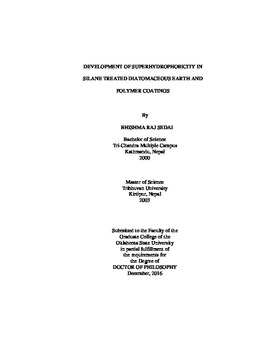| dc.contributor.advisor | Blum, Frank D. | |
| dc.contributor.author | Sedai, Bhishma Raj | |
| dc.date.accessioned | 2018-06-25T13:38:31Z | |
| dc.date.available | 2018-06-25T13:38:31Z | |
| dc.date.issued | 2016-12 | |
| dc.identifier.uri | https://hdl.handle.net/11244/300268 | |
| dc.description.abstract | This dissertation describes the development of superhydrophobicity in fluorosilane treated diatomaceous earth (DE) particles and polymer coatings. The amount of silane coupling agent on the surface of DE particles has been determined by thermogravimetric analysis (TGA). The presence of silane coupling agents on the DE particles has been confirmed by Fourier transform infrared spectroscopy (FTIR). The minimum amount of fluorosilane coupling agent required to exhibit superhydrophobicity has been determined. The development of the superhydrophobicity in the coatings with simple polymers like polystyrene (PS) or poly(vinyl acetate) (PVAc) as binders has been followed as a function of the particle loading using contact angle measurements and scanning electron microscopy. | |
| dc.description.abstract | The effect of particle morphology in the development of superhydrophobicity has been studied systematically. It was found that less-dense treated CelTix DE particles produced superhydrophobicity at 30 wt% of particles loading compared to more dense treated DiaFil DE (rod-shaped) and EcoFlat DE (irregularly shaped) particles with low molecular mass polystyrene binder system. The effects of particle morphology, surface area, porosity and density in the development of superhydrophobicity have been described. | |
| dc.description.abstract | The effect of viscosity of the binder solution in the development of superhydrophobicity has been observed. Changes in the solvent systems have not affected the superhydrophobicity for similar coating compositions. The DE particles were found to be robust and the coatings prepared with the sonicated DE samples also exhibited superhydrophobicity. | |
| dc.description.abstract | Additionally, untreated and treated diatomaceous earth particles and epoxy composites have been prepared. The thermal and dynamic mechanical properties of DE/epoxy composites have been evaluated. The mechanical properties of the DE/epoxy composites revealed that treated DE particles act as better reinforcing agents compared to untreated DE particles. | |
| dc.format | application/pdf | |
| dc.language | en_US | |
| dc.rights | Copyright is held by the author who has granted the Oklahoma State University Library the non-exclusive right to share this material in its institutional repository. Contact Digital Library Services at lib-dls@okstate.edu or 405-744-9161 for the permission policy on the use, reproduction or distribution of this material. | |
| dc.title | Development of superhydrophobicity in silane treated diatomaceous earth and polymer coatings | |
| dc.contributor.committeeMember | White, Jeffery L. | |
| dc.contributor.committeeMember | Weaver, Jimmie D., III | |
| dc.contributor.committeeMember | Krishnan, Sadagopan | |
| dc.contributor.committeeMember | Perk, J. H. H. | |
| osu.filename | SEDAI_okstate_0664D_15012.pdf | |
| osu.accesstype | Open Access | |
| dc.type.genre | Dissertation | |
| dc.type.material | Text | |
| thesis.degree.discipline | Chemistry | |
| thesis.degree.grantor | Oklahoma State University | |
